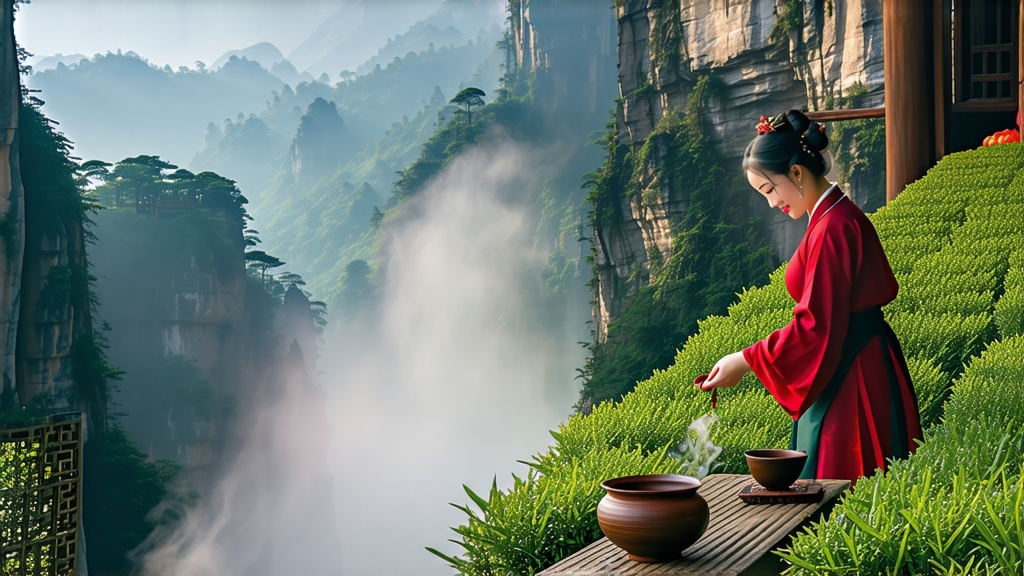
When Chinese tea lovers speak of “rock rhyme” – the elusive yan yun that haunts the palate like a struck bell – they are almost always talking about Da Hong Pao, the great “Big Red Robe” of Wuyi Mountain in northern Fujian. Few teas carry as much legend, geology, and craftsmanship in a single leaf. To the international drinker accustomed to the floral lift of Taiwanese high-mountain oolongs or the honeyed muscatel of Darjeeling, Da Hong Pao can feel almost subterranean: a slow-rolling bass note of roasted stone, cocoa, and orchid that arrives in waves rather than a single melody. Understanding why requires a journey into Ming-dynasty bandit lore, Song-dynasty imperial tribute lists, Jurassic-era cliffs, and the meticulous choreography of charcoal roasting that has barely changed in three centuries.
Legend first: in the early fifteenth century a Ming emperor’s mother lay gravely ill. Court physicians tried every elixir until a monk from Wuyi presented a tea plucked from six bushes clinging to a narrow ledge above the Nine-Dragon Gorge. The empress recovered; the emperor, grateful, sent crimson silk robes to drape the bushes, declaring them sacred. Thus “Big Red Robe” entered the lexicon. Historians debate the medical miracle, but tax records from 1539 indeed show those same mother trees exempted from levies, proving the bushes were already prized. Today the original six still stand, caged and guarded, their gnarled trunks older than Shakespeare. Cuttings taken in the 1980s created the “queen mother” orchards that now supply 99 % of authentic Da Hong Pao, so modern drinkers need not fear they are sipping a national monument.
Geology next. Wuyi’s Danxia landform thrusts vertical cliffs of purple-red tuff and quartz conglomerate above a zig-zag river. Day-night temperature swings can exceed 15 °C; mist drifts up the gorge, refracting light so that leaves photosynthesize slowly, stacking amino acids and aromatic volatiles. The porous rock drains quickly, forcing roots to dive three metres for water, mining potassium, fluorine, and rare earths that translate into a palpable minerality on the tongue. Locals call this lithic signature “rock bone” – the skeletal structure beneath the flesh of fragrance.
Da Hong Pao is not a single cultivar but a blend of four indigenous bushes: Qi Dan, Bei Dou, Que She, and the famously fragrant but low-yield Tie Luo Han. Each brings a voice to the choir: Qi Dan supplies dark chocolate depth, Bei Dou contributes bright apricot, Que She offers lilac high notes, while Tie Luo Han adds the cooling camphor finish that makes yan yun linger. Blending is an inherited art; master cuppers roast and taste up to eighty micro-batches, then “marry” them in 5–7 % increments until the ensemble reaches the classical balance codified in Qing-era manuals.
Plucking begins in late April when three and a half leaves have unfolded – the “half” being the fish-leaf still partly curled. Workers climb bamboo ladders lashed to the cliff face at dawn to avoid the 10 a.m. sun that would oxidise leaf edges too quickly. The picked leaf is carried downhill in wicker baskets lined with hemp cloth to prevent bruising; any crushed cell starts premature oxidation and would flatten the later layers of aroma.
Withering happens in three micro-stages unique to Wuyi. First, leaves are spread 3 cm deep on water-polished bamboo trays set inside a cave mouth where the temperature hovers at 28 °C and humidity at 65 %. After forty minutes the leaf loses its grassy edge; trays are then moved to a shaded courtyard for a further ninety minutes of “soft wither.” Finally, trays rest on slate tables heated from below by charcoal embers at 35 °C, a gentle coaxing that reduces moisture to 58 % without “baking” the enzymes needed for oxidation.
Oxidation itself is a dance between shaking and resting. Ten kilograms of leaf are tossed inside a rattan drum rotating at 18 rpm for three minutes, then poured into a waist-high pile and covered with wet linen for eight minutes. This cycle repeats six times over four hours, edge bruising progressing 15 % each round until 50 % of cells are ruptured – the sweet spot for Da